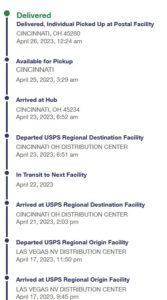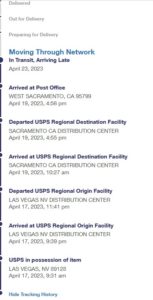My mother passed away last year (after a long and fruitful life). I filed her final tax returns–and money was due to both the IRS and California. I could not use IRS Direct Pay, nor could I have the funds debited from my bank account; thus, I mailed checks (and vouchers) to the tax agencies. I sent these on Monday, April 17th using certified mail.
Today, Thursday, April 26th, the IRS payment was received (it has not cleared my bank account yet, but should in the next day or so). Yes, it took nine days to be received. Here’s the tracking for it:
As to why it sat around for four days in Cincinnati, you’ve got me. No matter, because the payment deadline is a postmark deadline I’m fine and my mother’s tax to the IRS for her final return was timely paid.
Meanwhile, Sacramento is a lot closer than Cincinnati; you’d expect the payment to California to have already been processed. Well, no:
The payment’s been somewhere in Sacramento since April 19th and is still somewhere other than with the Franchise Tax Board (FTB), California’s income tax agency. Again, I have no answers for the postal service’s ineptitude but sooner or later (perhaps that should be later or later) the payment will make it to the FTB. Because I mailed it certified mail–and have that proof–even if the payment is lost I’ll be fine.
Each of these envelopes cost $4.78 (total) to mail; that’s $4.15 more than first class mail. The late payment penalty and interest would be in the hundreds of dollars for each of these payments. If I had not mailed these certified mail, I could be looking at those penalties. (Yes, the tax agencies are supposed to look at postmarks but I’ve received plenty of mail without postmarks.)
There’s one other issue: The IRS (and other tax agencies) need to lengthen the time period for responding to notices. These mail delays are typical–and the IRS needs to build in current realities to mailed responses to notices.
Tags: 2023.Tax.Season, USPS

